Articulating Bathroom Mirrors: Design & Functionality
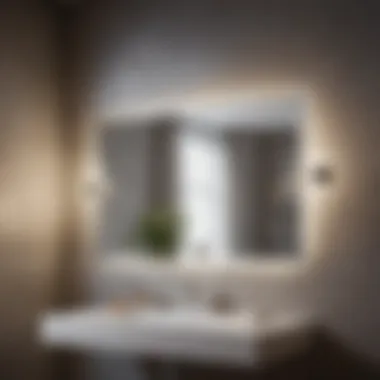
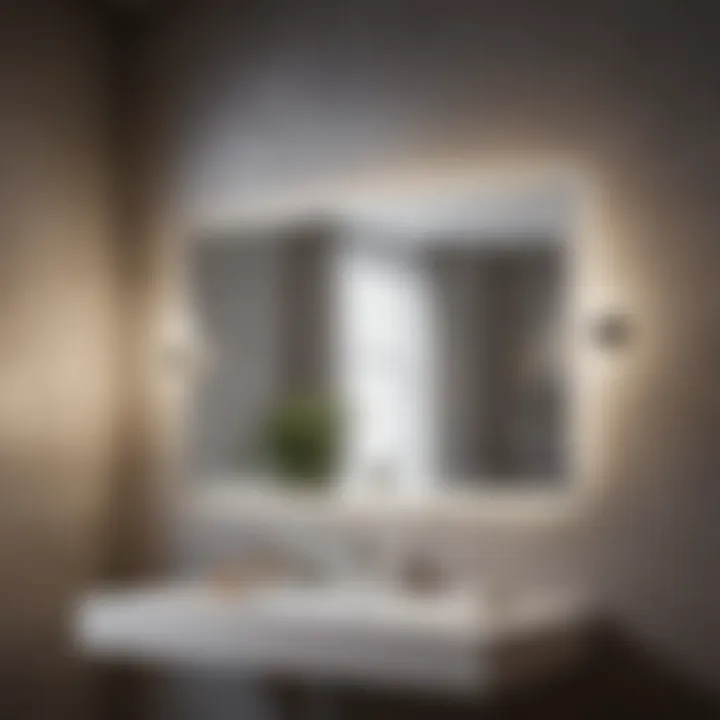
Intro
Articulating bathroom mirrors have gained notable traction in contemporary bathroom design. Their unique functionality and aesthetic appeal provide not only a practical solution but also serve as a stylish focal point. The intricate relationship between utility and design cannot be overstated—these mirrors are more than simple reflections; they embody the essence of thoughtful bathroom planning. Understanding their significance requires a closer look into various elements such as design inspirations, product recommendations, as well as installation and maintenance considerations.
This article will guide you through the key features that define articulating bathroom mirrors. From their expanding range of styles to their color palettes, there is much for homeowners to consider. Moreover, thoughtful product recommendations will help streamline your choices. By the end, readers will be equipped with the knowledge needed to select and maintain their mirrors effectively, enhancing the overall ambiance of their personal spaces.
Design Inspirations
Designing a bathroom around articulating mirrors opens up a world of possibilities. Their versatility allows for seamless integration into diverse styles, aligning with the homeowner's vision and the bathroom’s overall theme.
Trending Styles
Current trends in bathroom design favor minimalism and functionality. Articulating mirrors provide a sleek appearance without sacrificing performance. Some trending styles include:
- Vintage Elegance: Featuring ornate framing and intricate detailing, vintage-inspired mirrors add a touch of class.
- Modern Minimalism: With clean lines and a simple aesthetic, these mirrors focus on functionality while maintaining visual appeal.
- Industrial Chic: Utilitarian models with metal finishes resonate well with rustic themes, providing a striking contrast against softer bathroom accents.
These styles cater to varying tastes and can dramatically transform a bathroom’s aesthetic. Every option represents a unique approach to integrating this essential feature into personal spaces.
Color Palettes
The choice of colors in bathroom design plays a crucial role in the overall ambiance. Articulating mirrors can enhance these palettes effectively. Here are some popular color considerations:
- Neutral Tones: Whites, grays, and beiges create timelessness and flexibility in design.
- Bold Accents: Deep blues, greens, or even gold can add dramatic flair, making the mirror a central visual element.
- Pastels: Softer colors provide a calming effect and work well in light-themed bathrooms.
Choosing the right color palette not only elevates the mirror's appearance but also ensures harmony with other bathroom elements.
Product Recommendations
When selecting articulating mirrors, certain features should come to the forefront. Key aspects like durability, adjustability, and ease of installation make specific mirrors stand out. Here are a few recommendations:
- Moen Ascent: Known for its robust design and smooth adjustability, this mirror fits various bathroom styles.
- Jerdon Tri-Fold: A versatile option, offering multiple viewing angles suited for close-up grooming routines.
- Kohler K-10800: A wall-mounted articulating mirror that combines style with practicality, perfect for smaller spaces.
Each of these choices emphasizes function without compromising on visual appeal, catering specifically to dynamic bathroom design.
End
Articulating bathroom mirrors represent a thoughtful addition to personal spaces. Every detail, from design inspirations to product recommendations, contributes to the effectiveness and aesthetic value of these mirrors. Homeowners can realistically enhance functionality while embracing modern styles. Ultimately, investing time in understanding articulating mirrors will lead to truly remarkable bathroom transformation.
Understanding Articulating Bathroom Mirrors
Articulating bathroom mirrors have evolved into essential components of modern home design. They offer more than mere reflection; they blend functionality with aesthetics, enhancing the overall experience in personal spaces. Understanding the role of these mirrors can help homeowners make informed decisions that cater to both practical needs and design aspirations.
Definition and Functionality
Articulating bathroom mirrors are mirrors that can be adjusted and positioned at various angles due to their attached articulating arms or hinges. This adjustability allows users to achieve an optimal viewing angle for grooming activities such as shaving, applying makeup, or styling hair. Beyond functionality, these mirrors often come with additional features such as LED lighting and magnification, which improve usability in diverse light conditions and offer close-up views for detailed tasks.
The primary advantage of articulating mirrors lies in their versatility. Unlike fixed mirrors that offer only one perspective, articulating mirrors can adapt to various user heights and preferences. This adaptability makes them suitable for households with members of differing heights, ensuring that everyone can benefit from a clear view.
Historical Context
The use of mirrors dates back to ancient civilizations, where polished surfaces were used for personal grooming and ceremonial purposes. However, the concept of articulating mirrors is more recent, stemming from innovations in design and technology oriented towards comfort and utility in the home environment.
Historically, the placement of mirrors in bathrooms was limited by wall space. Over time, the need for versatile, functional designs led to the invention of wall-mounted articulating mirrors in the mid-20th century. These designs allowed homeowners to optimize their bathroom space effectively, providing a cleaner and more organized environment. Today, articulating mirrors are available in various styles, materials, and sizes, reflecting current trends in interior design and catering to the diverse preferences of modern homeowners.
"Articulating mirrors exemplify the blend of form and function, making them indispensable in contemporary bathroom designs."
Understanding the evolution of these mirrors can help individuals appreciate their value in the context of interior design and daily life. Their growing popularity continues to reshape the standards of bathroom aesthetics, merging beauty with practicality.
Types of Articulating Mirrors
Understanding the various types of articulating bathroom mirrors is essential for anyone looking to upgrade their space. Each type serves specific needs and offers unique features. Let's explore these individual categories in detail, allowing homeowners to make informed choices based on function, style, and practicality.
Wall-mounted Mirrors
Wall-mounted articulating mirrors are among the most popular options in modern bathrooms. They provide a fixed installation, thus maximizing floor space. This type of mirror is typically adjustable, allowing users to change the angle for better visibility. Wall-mounted mirrors can be equipped with useful features like built-in lighting or magnification.
These mirrors are often favored for their versatility. Homeowners can position them at any height, depending on user needs. For instance, a person who requires a closer look, such as for shaving or makeup application, can adjust the mirror to their convenience.
This type of mirror can also save valuable space in smaller bathrooms. By being mounted on the wall, they contribute to a clean and organized atmosphere.
"Opt for a wall-mounted mirror to enhance your bathroom’s functionality while conserving floor space."
Freestanding Mirrors
Freestanding articulating mirrors add a different dimension to bathroom aesthetics. They are not fixed to the wall, which provides flexibility in placement. This type can be moved around, allowing one to change its location based on lighting or usage preferences.
These mirrors generally come with a sturdy base that ensures stability. They can also feature a dual-sided design, offering a regular reflection on one side and magnification on the other. Such options meet various grooming needs, making them a valuable addition to any bathroom.
Freestanding mirrors are ideal for larger spaces where more mobility is desired. They can be positioned near bathtubs or in corners, wherever they fit the user's style and needs seamlessly.
Magnifying Mirrors
Magnifying mirrors are designed specifically for close-up tasks. Often wall-mounted or freestanding, they come with different magnification levels, usually from 2x to 10x. This feature makes them especially useful for detailed work, such as applying makeup or tweezing.
Many magnifying mirrors also include built-in lighting, which enhances visibility even in low-light settings. This aspect is crucial, as proper lighting helps in achieving a flawless look.
These mirrors often have swivel capabilities, allowing for simple adjustments to the desired angle. Their compact design means they can fit into smaller spaces, making them versatile for various bathroom layouts.
Benefits of Articulating Mirrors
Articulating mirrors offer numerous advantages that make them a valuable addition to any bathroom. Their design enhances functionality in several key ways. Homeowners seek mirrors that not only serve a purpose but also elevate their space aesthetically. An articulating mirror achieves both by combining practicality with style. This section will explore three critical benefits: space optimization, enhanced lighting, and versatile angling.
Space Optimization
Articulating mirrors can save valuable space in compact bathrooms. Their ability to be mounted on a wall and swivel allows for greater movement compared to traditional mirrors. This feature is especially useful in smaller bathrooms where every inch counts. When not in use, these mirrors can be pushed flat against the wall, minimizing their footprint.
Homeowners can appreciate how this design maximizes the available area, making the bathroom feel larger and more open. Additionally, with the option to adjust the mirror’s position, users can utilize nooks and crannies that would otherwise remain underused. Furthermore, they can easily accommodate multiple users, allowing everyone to access the mirror easily without crowding.
Enhanced Lighting

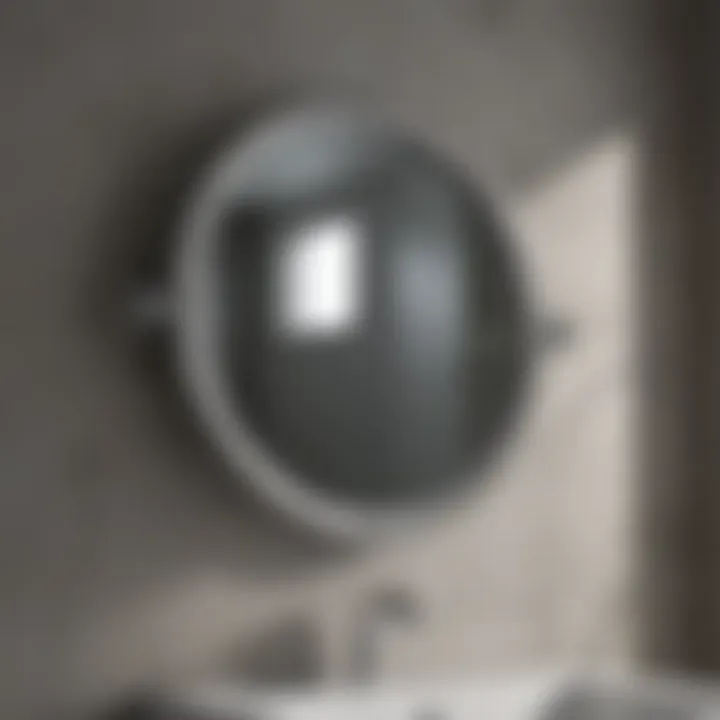
The placement and design of articulating mirrors can significantly improve the lighting in a bathroom. With their adjustable angles, users can manipulate angles to capture natural light more effectively. If positioned near a window, the mirror can reflect sunlight into darker areas of the room, creating a well-lit ambiance.
Moreover, some articulating mirrors come equipped with integrated lighting features. This can include backlighting or side sconces that illuminate the face evenly. Good lighting is essential for grooming tasks, such as shaving or applying makeup. Improved lighting can help enhance visibility, ensuring that every detail is easily noticed.
Versatile Angling
Another key benefit of articulating mirrors is their ability to be tilted and adjusted for optimal viewing angles. This versatility is crucial for personal grooming and everyday tasks, as it allows users to see themselves from various positions. The articulating arm gives freedom to adjust the mirror closer or farther away based on preference.
This feature is crucial for specific activities such as applying skincare products or styling hair. By tailoring the angle to the user's height and needs, the mirror can offer a more comfortable experience. Importantly, this adaptability also caters to family members of differing heights, ensuring that everyone can use the mirror without straining or needing to adjust furniture.
"The ability to adapt a mirror’s angle makes it indispensable, especially in shared bathroom spaces."
Installation Considerations
Installation of articulating bathroom mirrors is crucial to maximize their functionality and aesthetic appeal. Understanding how to properly install this type of mirror means considering various factors that can affect the user's experience. A well-installed mirror enhances both its usability and the overall atmosphere of the bathroom. This section delves into important elements such as wall type compatibility, mounting mechanisms, and height regulations.
Wall Type Compatibility
Before installing an articulating mirror, knowing the compatibility of the wall material is essential. Different walls, whether they are drywall, plaster, or tile, require specific approaches.
- Drywall: Standard in many homes, drywall allows for easy mounting. Anchors should be used to provide a secure hold.
- Plaster: Heavier than drywall, plaster walls may need additional support. Use toggle bolts or heavy-duty anchors to ensure stability.
- Tile: Consider the fragility of tile when installing an articulating mirror. A professional may be needed for drilling to prevent cracks.
Incompatibility between the wall surface and mounting system can lead to functional problems. A mirror not properly secured can be hazardous and diminish its intended use.
Mounting Mechanisms
The selection of a suitable mounting mechanism affects the safety and functionality of the articulating mirror. There are various types of mounts, and each has its own benefits:
- Fixed Brackets: These offer a secure and stable installation, suitable for mirrors that will not be adjusted frequently.
- Pivoting Mounts: These allow for flexible positioning, which is ideal for mirrors that need to be angled for optimal visibility.
- Swivel Arms: This type aids in adjusting the mirror easily, accommodating different user heights and positions.
Choosing the correct mechanism involves understanding how often the mirror will be adjusted and the overall weight of the mirror. A mismatch here can lead to inadequate support and potential accidents.
Height and Position Regulations
Correct positioning of the mirrors is key for user comfort and effectiveness. Here are a few considerations for optimal height and positioning:
- Eye Level: Generally, mounting mirrors at eye level provides convenience. For adults, this is typically between 50 and 60 inches from the floor.
- User Height Variations: It may be beneficial to consider the height of all family members. Instruments like adjustable mounts can cater to both adults and children.
- Room Dimensions: Consider the space available. Ensure that the mirror does not obstruct other fixtures like sinks or cabinets.
Proper height and positioning not only improves usability but also elevates the room’s overall design.
In summary, installation of articulating mirrors is multifaceted. Attention to wall compatibility, mounting systems, and proper height is critical. By ensuring these elements are addressed, homeowners can achieve a balance of practical functionality and aesthetic enhancement in their bathrooms.
Material Choices
Material choices for articulating bathroom mirrors play a crucial role in defining both functionality and aesthetic appeal. Selecting the right materials can significantly affect durability, style, and overall satisfaction. Homeowners must consider various elements when it comes to material selection to ensure they make informed decisions that align with their personal preferences and bathroom design.
Glass Variations
The glass is often the focal point of any mirror. Various glass types can be used for articulating bathroom mirrors. Each type brings its characteristics to the overall design and functionality. For instance, standard float glass is common and provides a clear reflection. However, for a more premium feel, homeowners might opt for tempered glass. This type undergoes a process that strengthens it, making it safer and less likely to break under normal bathroom conditions.
Another option might be anti-fog glass. This is particularly useful in bathrooms where moisture is high. Mirrors with anti-fog properties maintain clarity even after a hot shower. Furthermore, those interested in luxury options might find mirrored glass appealing, as it adds a touch of elegance and sophistication.
Additionally, homeowners should consider their specific needs when choosing glass variation. Customization possibilities also exist, allowing for unique sizes and shapes. Keep in mind that the right choice of glass can enhance the functionality of the mirror significantly.
Frame Options
The frame of an articulating mirror influences both its durability and visual appeal. The materials used for frames can vary significantly. Metal frames, commonly made from stainless steel or aluminum, offer a modern , sleek look and unmatched durability. These frames resist moisture, making them ideal for bathroom settings.
On the other hand, wooden frames add a warm, classic touch. Homeowners can choose from rot-resistant woods or those treated specifically for high-moisture environments. This ensures that the frame maintains its beauty and strength over time.
Some homeowners might prefer plastic frames due to their lightweight nature and versatility in design. These frames can enhance the mirror without adding excess weight, which is particularly useful for articulating mirrors.
Choosing the right frame is not just about aesthetics. It can also affect how well the mirror integrates into the bathroom's overall decor. A well-chosen frame can act as a complement to other elements in the bathroom.
Durability Factors
Durability is another essential consideration in material choices for articulating bathroom mirrors. The bathroom environment is unique, with high humidity and frequent temperature changes. Therefore, the materials selected must withstand these conditions effectively.
For instance, the installation mechanisms must be robust to handle the motions of articulating mirrors. High-quality hinges and brackets made from stainless steel can ensure smooth movement and longevity.
Moreover, considering the coating on the glass is important. Some mirrors come with specialized coatings that not only enhance reflectivity but also protect against moisture and is less prone to tarnishing. This additional layer can extend the lifespan of the mirror significantly.
In summary, thoughtful material choice enhances the visual qualities and contributes to the practicality of articulating bathroom mirrors. Homeowners should evaluate glass variations, frame options, and durability to ensure optimal satisfaction with their selection.
Aesthetic Contributions
The aesthetic contributions of articulating bathroom mirrors cannot be overstated. These mirrors serve not only as functional pieces but also as integral design elements that enhance the overall appearance of a bathroom. They provide a focal point that can transform a bland space into a stylish sanctuary. Understanding the specific aspects of aesthetic contributions will help homeowners make informed choices that reflect their personal style and preferences.
Design Trends
In recent years, the design trends surrounding articulating mirrors have shifted towards more modern and innovative styles. Many homeowners are opting for sleek, minimalist designs that complement contemporary bathroom fixtures. This trend emphasizes clean lines and simplicity, relying on the mirror's functionality to enhance the space without overwhelming it.
Additionally, vintage and retro styles are gaining traction. This resurgence adds character to bathrooms while allowing individuals to express their unique tastes. For example, a brass-framed articulating mirror can serve as a striking contrast in a modern bathroom, effectively blending the old with the new.
Color Schemes
Color schemes play an important role in the aesthetic appeal of articulating bathroom mirrors. Neutral tones remain a popular choice, providing versatility and the ability to match various decor styles. Shades like white, black, or metallic finishes can create a timeless look. However, bold colors are also making a statement in bathroom designs.
Incorporating mirrors with colored frames can add vibrancy and personality to the space. For instance, a deep navy frame can create a striking contrast against light-colored walls, bringing depth into the bathroom. It's essential to consider how the mirror’s color will relate to other elements in the room like tiles, countertops, or cabinetry.
Integration with Existing Decor
Successfully integrating articulating mirrors with existing decor is essential. The key is to ensure consistency in style and theme throughout the bathroom. When selecting a mirror, consider your bathroom's aesthetic, whether it leans toward modern, traditional, or rustic.
For minimalist bathrooms, a frameless articulating mirror can provide a seamless integration. Alternatively, in a traditional setup, ornate frames or those with intricate details can enhance the overall decor.
Moreover, coordinating the mirror with other bathroom accessories, such as lighting fixtures or towel racks, can create a cohesive look. Colors, materials, and designs should complement each other to foster harmony in the space.
Important Note: A well-chosen articulating bathroom mirror not only serves its practical purpose but also enhances the visual allure of the environment.
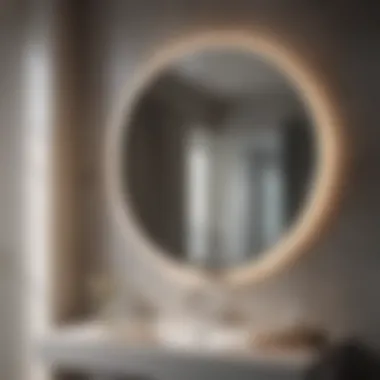
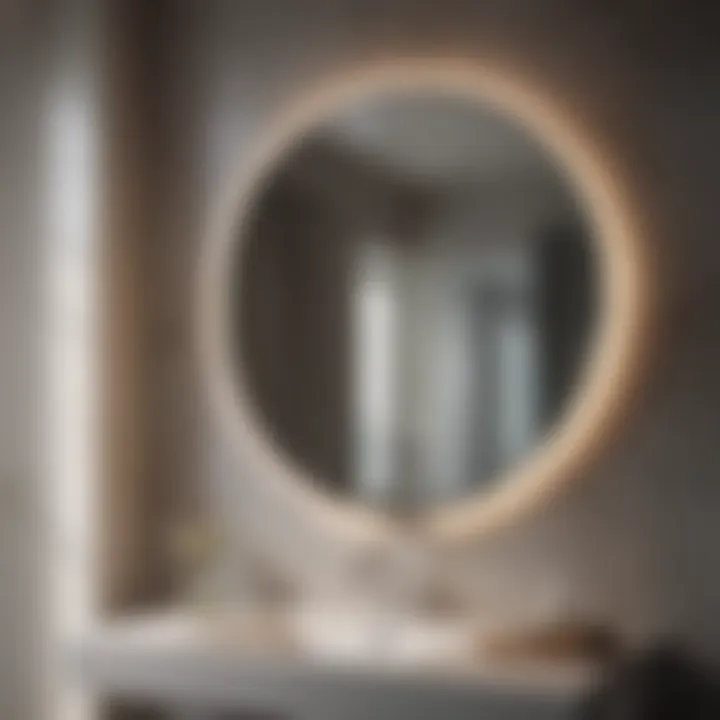
By focusing on the aesthetic contributions, homeowners can elevate their bathrooms into thoughtfully designed spaces. An articulating mirror’s ability to enhance both functionality and style makes it a valuable investment.
Maintenance and Care
Maintaining articulating bathroom mirrors is essential for their longevity and functionality. These mirrors not only serve a practical purpose by providing reflections but also enhance the aesthetic appeal of the bathroom. Proper care ensures that they remain free of damage, look new, and function correctly. Ignoring maintenance can lead to tarnish, scratches, or even mechanical failure of the articulation mechanisms. Cleaning and care strategies, which are straightforward, can significantly extend the life of these fixtures and keep them looking impeccable.
Regular Cleaning Techniques
To keep articulating mirrors in optimal condition, regular cleaning is imperative. Dust and grime can accumulate quickly in humid environments like bathrooms, impacting visibility and hygiene. Here are some effective techniques for cleaning your articulating mirror:
- Use a microfiber cloth: Microfiber is gentle on the mirror surface and reduces the risk of scratches. It also captures dust and dirt effectively.
- Glass cleaner or homemade solution: Choose a glass cleaner or create a solution with equal parts water and vinegar. Spray lightly onto the cloth rather than directly on the mirror to avoid excess moisture that can seep into frames.
- Avoid harsh chemicals: Avoid using abrasive cleaners or scrubbing pads, as they may damage the reflective surface and frame.
- Frequency of cleaning: It is recommended to clean the mirror weekly or bi-weekly, depending on the humidity levels and usage frequency. This will help maintain clarity and shine.
Handling Damage
Even with careful cleaning, accidents can occur. It is vital to be proactive in handling any damage to ensure that it does not worsen and remains safe to use. Here are steps to address damage effectively:
- Assess the type of damage: Common issues include scratches, cracks, or looseness in the mounting. Identify the specific problem before proceeding.
- For scratches: If the scratch is minor, a glass polish may help reduce its visibility. Applying a small amount with a soft cloth and buffing gently can yield results. For deeper scratches, a professional repair may be necessary.
- For cracks: A crack can compromise the integrity of the mirror. It is advised to avoid using it until it can be replaced or repaired. Temporary fixes like clear tape can prevent further splintering.
- Check the articulation mechanism: If the mirror seems loose or difficult to adjust, inspect the mounting brackets. Tightening screws may resolve the issue. If the mechanism is damaged, professional assistance may be required to fix it.
- Consider a warranty: Many articulating mirrors come with warranties. If damage occurs soon after purchase, consult the manufacturer for potential repair or replacement options.
Maintaining articulating mirrors through regular cleaning and prompt attention to damage can greatly enhance their durability and functionality.
Expert Recommendations
In the realm of articulating bathroom mirrors, expert recommendations serve a critical role. They guide homeowners in making selections that enhance both the functionality and aesthetics of their bathrooms. It is essential to consider factors such as size, style, and lighting when choosing a mirror. The right choice can lead to a significant improvement in daily routines and the overall ambiance of the space.
Choosing the Right Size
Selecting the appropriate size for an articulating bathroom mirror is paramount for optimizing both utility and visual appeal. A mirror that is too large may overwhelm a small bathroom, while one that is too small risks underwhelming the space's design. The general guideline suggests that the width of the mirror should be proportionate to the vanity beneath it, typically being about 75% of the vanity's width.
Here are key points to keep in mind:
- Measure the available wall space. Ensure there is room not only for the mirror but also for comfortable usage.
- Consider the height at which the mirror will be mounted. This should account for both shorter and taller users. Ideally, the mirror's center should be about eye level.
- Evaluate the overall design of the bathroom. The mirror must complement the existing elements, including cabinetry and fixtures.
In summary, size selection is not merely a question of measurement; it significantly impacts functionality and style.
Optimal Lighting Conditions
The effectiveness of articulating bathroom mirrors extends beyond their physical characteristics. Lighting plays a crucial role in maximizing their functionality. Proper lighting enhances visibility and ensures that tasks such as shaving or applying makeup are executed efficiently.
Consider these aspects when assessing lighting conditions:
- Natural Light: If possible, position mirrors where they can benefit from natural light. Morning sunlight can provide a flattering effect for daily grooming.
- Light Fixtures: Use fixtures that are bright but not harsh. LED bulbs often simulate natural light well. Aim for fixtures on either side of the mirror to reduce shadows.
- Adjustability: Articulating mirrors allow for positioning. If the angle of the mirror can be adjusted, this helps reflect light optimally, leading to better illumination.
"Lighting is as vital as the mirror itself. It complements the mirror and enhances usability."
By carefully considering the lighting around the articulating mirror, one can create a more functional and inviting bathroom space.
Comparing Articulating Mirrors to Other Mirrors
In the realm of bathroom design and functionality, the choice of mirrors plays a critical role. Articulating mirrors stand out distinctly when compared to fixed and smart mirrors. Understanding their unique attributes is essential for homeowners aiming to maximize both utility and aesthetics in their personal spaces.
When examined closely, articulating mirrors offer unique flexibility. Their ability to extend, retract, or tilt allows users to position them at the most advantageous angle. This inherent versatility ensures that all users, regardless of height or preference, can achieve a comfortable view. In contrast, fixed mirrors are static, offering no adjustment capability. While they serve their purpose reasonably well, they lack the adaptability that many modern users require.
Articulating mirrors cater not only to size diversity among users but also promote better lighting. By adjusting the angle of the mirror, one can manipulate how light interacts with their face during grooming or makeup application. This feature can significantly enhance personal grooming tasks, making articulating options invaluable in any bathroom setting. In contrast, fixed mirrors often reflect light in a set direction, which can be less than ideal for detailed tasks.
"The strategic placement and ability to adjust articulating mirrors make them a more functional choice for those seeking personalized experiences in their daily grooming routines."
Fixed Mirrors
Fixed mirrors are a traditional choice found in many homes. They are typically mounted directly to a wall and do not offer any adjustability. Their main advantages include simplicity and a straightforward installation process. They can come in various sizes, shapes, and frames, providing aesthetic options for many styles of bathroom decor.
However, their limitations can be significant. For instance, fixed mirrors do not cater to different user heights or preferences. When multiple people share a bathroom, it can be challenging to find a comfortable angle or view for everyone. Moreover, the lack of mobility can make them less functional in spaces where lighting isn't ideal. Fixed mirrors also tend to take up more wall space, which could be inefficient in smaller bathrooms.
Smart Mirrors
Smart mirrors represent the latest advancements in mirror technology. They offer a combination of functionality and style, often integrating with digital devices. Smart mirrors can feature built-in LED lighting, touch screens, and even voice-activated commands, providing a plethora of benefits for users.
While articulating mirrors focus on mobility and adjustment, smart mirrors offer high-tech solutions. Users can manage their daily tasks, like weather updates or calendar checks, through the mirror. However, they often come at a higher cost. The added complexity and technology may not be necessary for everyone. In smaller bathrooms, the lack of physical adjustability can also be a drawback compared to articulating mirrors.
Both fixed and smart mirrors have their merits, but articulating mirrors often present a well-rounded approach catering to a more hands-on experience. This can significantly enhance daily skincare and grooming routines in a way that their counterparts struggle to match.
Current Market Trends
Understanding the current market trends regarding articulating bathroom mirrors is essential for homeowners and designers alike. This section sheds light on the ongoing shifts in consumer preferences and the increased focus on sustainability within the marketplace. Recognizing these trends not only aids in informed purchasing but also reflects broader societal changes toward home improvement and personal space design.
Consumer Preferences
Today’s consumers show a strong inclination toward functionality and aesthetics in their choice of bathroom mirrors. The versatility of articulating mirrors has captured attention, as they offer greater flexibility in placement and usage. These mirrors allow individuals to adjust the angle and distance as needed, enhancing the user experience significantly.
Moreover, clean lines and modern designs are becoming standard in articulating mirrors. Preferences lean towards sleek frames or frameless designs that create an illusion of space. Many consumers prioritize easy installation and maintenance, reflecting a desire for practical solutions that fit seamlessly into their daily routines.
"The choice of a bathroom mirror is not just about style. It’s about utility and how it fits into personal and family needs."
Customization is also key. Homeowners prefer products that can be tailored to their specific needs, such as integrated lighting or smart mirror features that provide additional functionalities like defogging or Bluetooth connectivity.
Sustainable Options
The rise of environmental consciousness among consumers has spurred a significant shift towards sustainable options in bathroom fixtures. Articulating mirrors are now being manufactured using eco-friendly materials and processes. For example, companies are opting for recycled glass and sustainable wood for frames, minimizing their environmental footprint.
Additionally, energy-efficient lighting integrated into mirrors is gaining popularity. LED lights not only provide better illumination but also consume less energy compared to traditional bulbs, aligning with consumers’ increasing desire for green solutions in their homes.
Some brands are also investing in ethical production methods that highlight fair labor practices. This resonates with a growing demographic of consumers who are not only concerned with their purchases' direct impact but also with their broader social implications.
Articulating Mirrors in Different Bathroom Styles
Articulating mirrors serve more than just functionality in bathrooms; they also contribute to a room's overall aesthetic. The choice of an articulating mirror can transform the visual appeal of the space while enhancing its practicality. Each bathroom style comes with its own unique requirements and trends, making it crucial to consider how these mirrors fit within various designs. This section explores how articulating mirrors align with modern, traditional, and minimalist bathroom styles, addressing specific elements and benefits that tailor the selection process for homeowners.
Modern Bathrooms
In modern bathrooms, simplicity and clean lines are key elements. Articulating mirrors can enhance this aesthetic by providing sleek designs that are both functional and stylish. They often come with minimalist frames and clever features, like LED lighting, which integrates well with contemporary decor.
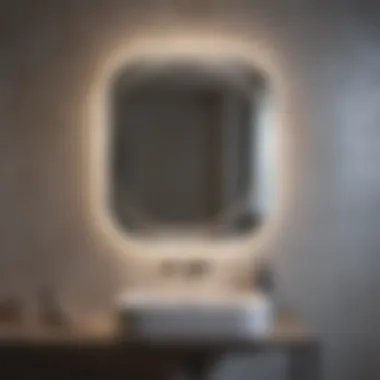

Choosing a wall-mounted articulating mirror can free up counter space, allowing for a more open feel in the bathroom. Homeowners can adjust the angle of the mirror, providing versatility for different tasks, whether it is shaving or applying makeup. Furthermore, the sleek appearance contributes to a sense of spaciousness, essential in smaller modern bathrooms.
Traditional Bathrooms
Traditional bathrooms emphasize classic design and elegance. In these settings, articulating mirrors can add to the charm while serving a practical purpose. Often framed in ornate designs, these mirrors may feature vintage details, which resonate well with the overall decor.
The versatility of articulating mechanisms allows for easy positioning. This can be especially beneficial in crowded spaces where fixed mirrors might limit usability. A well-chosen articulating mirror can act as a focal point, drawing attention without overpowering other design elements. It’s about striking a balance, ensuring that the mirror complements the traditional fixtures and fittings typically found in such bathrooms.
Minimalist Bathrooms
Minimalist bathrooms prioritize functionality and simplicity, which makes articulating mirrors an ideal choice. The design philosophy focuses on eliminating excess, thus a mirror that can adjust and serve multiple purposes is valuable. These mirrors typically eschew elaborate framing in favor of simpler outlines, aligning perfectly with minimalist principles.
An articulating mirror in a minimalist bathroom setup can help save space and reduce clutter. When the mirror is not in use, it can be easily pushed away, creating an unobstructed view. By reflecting light effectively, these mirrors can also help to make the space feel larger, promoting a sense of tranquility that is paramount in minimalist design.
"Choosing the right articulating mirror can enhance both functionality and aesthetic appeal, making it an essential consideration for any bathroom renovation."
Common Misconceptions
Articulating bathroom mirrors often come with a myriad of misconceptions that can influence a homeowner's decision-making process. Understanding these misconceptions is important, as it sets the stage for making informed choices tailored not only to aesthetics but also to utility in the bathroom space. Many people overlook these mirrors, believing they are too costly or bulky for their bathrooms. By addressing these myths, we can reveal the true value and benefits of articulating mirrors.
Cost vs. Value
One of the most prevalent misconceptions regarding articulating bathroom mirrors is the assumption that they are excessively expensive. While it is true that some high-end models boast significant price tags, there is a wide range of options available that cater to various budgets. When evaluating cost, it is crucial to differentiate between initial investment and long-term value.
Customers should consider the following factors:
- Durability: Articulating mirrors, particularly those constructed with high-quality materials, tend to last longer than regular fixed mirrors. Investing in a durable product often saves money on replacements over time.
- Utility: These mirrors provide adjustable angles that enhance usability for various activities, such as shaving or applying makeup. This functionality adds intrinsic value that fixed mirrors may lack.
- Aesthetic Appeal: An articulating mirror can elevate the overall appearance of a bathroom, potentially increasing the home’s market value if renovation is ever considered.
Thus, when you weigh the cost against the value offered by articulating mirrors, investing in one can be justified both from a functional perspective and aesthetic contribution.
Space Limitations
Another common misconception is that articulating mirrors require expansive bathroom space. This belief limits many individuals from considering these functional accessories in smaller bathrooms, where space is often at a premium. However, articulating mirrors are designed for versatility. They can be mounted on walls, and some models can retract, making them ideal for confined areas.
Consider the following advantages of articulating mirrors in smaller bathrooms:
- Adjustability: These mirrors can be angled towards the user, making them effective even in tighter spaces.
- Foldable Options: Certain models can fold against the wall when not in use, freeing up space for other activities.
- Wall-mounted Solutions: Many articulating mirrors are specifically designed to optimize wall space, which is vital in smaller bathrooms.
"Articulating mirrors offer a solution that merges style with practicality, making them an efficient choice even in limited spaces."
By correcting these misconceptions regarding cost and space, homeowners can make well-informed decisions about incorporating articulating mirrors into their bathrooms. In summary, understanding these elements is integral for enhancing both the functionality and visual appeal of bathroom spaces.
User Experiences
User experiences play a crucial role in understanding the functionality and practicality of articulating bathroom mirrors. Analyzing user interactions offers insights into the advantages and possible shortcomings of these mirrors. Ultimately, these experiences can guide potential buyers in making informed decisions.
Customer Feedback
Customer feedback serves as a direct line to the real-world implications of using articulating mirrors. Reviews often highlight both positives and negatives, giving prospective owners a balanced perspective. Many users praise the flexibility of these mirrors, enjoying the ability to adjust angles to achieve the optimal view. In particular, those who engage in detailed facial care routines often find articulating mirrors indispensable.
On the downside, some customers mention installation challenges. The complexity may vary depending on wall types and mounting mechanisms. Reviewing feedback from both satisfied and dissatisfied customers can illuminate these factors, allowing for better strategic planning when selecting and installing a mirror.
Pros and Cons of Customer Feedback:
- Pros:
- Cons:
- Flexible positioning for various tasks.
- Enhances overall bathroom aesthetics.
- Convenient for detailed makeup application and shaving.
- Installation difficulties noted by some users.
- Some mirrors may not have sufficient magnification or lighting options for specific needs.
Usage Scenarios
Understanding usage scenarios expands the context in which articulating mirrors function. These mirrors are not just decorative; they have a purpose rooted in convenience. For instance,
- Daily skincare and makeup routines benefit from adjustable angles, allowing users to see their faces clearly.
- Shaving tasks can be performed more safely and accurately with mirrors positioned at the right height and angle.
- Hair styling also gains precision through the versatility of articulating mirrors.
In homes with multiple users, articulating mirrors serve everyone well, adapting to different heights and preferences. Additionally, in smaller bathrooms, these mirrors help conserve space while maximizing utility.
Ultimately, user experiences encapsulate the tangible benefits and limitations of articulating bathroom mirrors, underscoring their vital importance in this article. By paying careful attention to these perspectives, homeowners can choose mirrors that align not only with their needs but also with their aesthetic preferences.
Future of Articulating Mirrors
The future of articulating mirrors is a pivotal topic in the realm of bathroom design and technology. This segment of the article examines how advancements in technology and shifts in design preferences are shaping the development of these mirrors. As aesthetics and functionality converge, articulating mirrors continue to play an essential role in enhancing user experience in personal spaces.
Technological Innovations
Technological advancements have significantly influenced the design and functionality of articulating mirrors. Smart features are increasingly becoming standard in these mirrors. Many models now integrate LED lighting to provide optimal illumination for various activities such as makeup application or grooming. The use of voice-activated controls is also rising. Users can adjust brightness or even change light temperatures based on their needs. The emergence of anti-fog technology is another game changer, ensuring clear visibility even in steamy environments.
These innovations contribute to energy efficiency. LED lighting is known for its longevity and low energy consumption. This is important for households looking to reduce their utility bills and carbon footprint. Moreover, the incorporation of sensors that adjust lighting based on ambient light levels helps maintain a perfect balance, enhancing usability.
Overall, these technological advancements not only improve the usability of articulating mirrors but also align with modern sustainable practices, making them a worthy investment for homeowners.
Evolving Design Preferences
The design landscape of articulating mirrors is undergoing significant transformation. Contemporary interior design trends favor minimalistic and sleek looks, which also reflects in the design of mirrors. Homeowners are now opting for mirrors that blend seamlessly with their bathroom decor, moving away from bulky or overly ornate styles. Articulating mirrors are hence becoming sleeker with streamlined frames and sophisticated finishes.
Color preferences are shifting towards neutral tones that can complement a variety of bathroom styles. Matte finishes and metallic touches are also on the rise. This evolution in design preferences emphasizes both elegance and functionality. Articulating mirrors are no longer just practical items; they are becoming integral elements of personal style.
"The right mirror can transform a simple space into a statement of personal taste."
In addition, with the increasing focus on customizable features, many manufacturers now allow users to select frame styles, colors, and even lighting options tailored to their unique taste. This characteristic enhances the appeal of articulating mirrors. As design continues to evolve, it becomes evident that these mirrors are not just fixtures; they are reflections of homeowner identity and lifestyle.
Overall, understanding the technological innovations and evolving design preferences in articulating mirrors is crucial. These aspects are not just trends but essential elements that facilitate comfort and enhance the visual appeal of space, ultimately influencing purchasing decisions for homeowners.
Epilogue
The topic of articulating bathroom mirrors holds significant importance in this article. It encapsulates the essence of both functionality and aesthetic appeal in bathroom spaces. Articulating mirrors serve not just as reflective surfaces but as versatile tools that enhance everyday routines. Their ability to optimize space and adapt to various lighting conditions makes them invaluable in modern bathrooms.
Summary of Key Points
- Versatility: Articulating mirrors offer flexible angling, accommodating various users and tasks. This adaptability is paramount in family households where different heights and preferences exist.
- Space Efficiency: These mirrors can be mounted to save space, particularly in smaller bathrooms. They can swing away when not in use, maximizing the available area.
- Design Integration: Articulating mirrors come in diverse styles that can complement existing decor, making them not just functional but also a stylish addition to any bathroom.
- User Experience: Positive customer feedback highlights the convenience and enhanced functionality provided by these mirrors, reinforcing their value in everyday life.
Final Thoughts
In closing, articulating bathroom mirrors represent a blend of practicality and design. They are essential for those who value functional elegance in their personal spaces. Choosing the right articulating mirror involves considering various elements such as size, style, and installation options. With the growing trend of home aesthetics, focusing on how these mirrors can enhance your bathroom experience is worthwhile. As technology evolves, future designs may incorporate smart features, further augmenting their functionality. Investing in an articulating mirror is not just a purchase; it is an enhancement to one's daily life, ensuring both ease of use and impeccable style.



